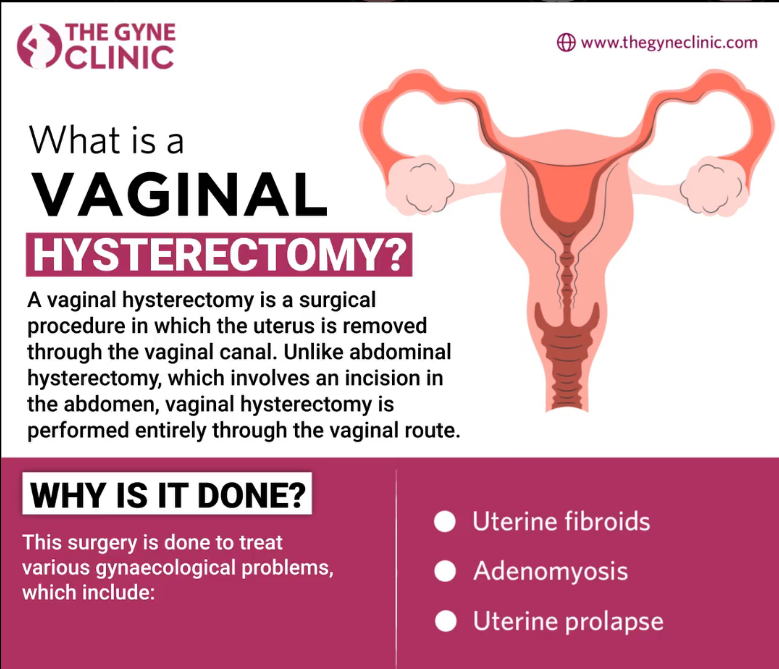
Vaginal Hysterectomy: Purpose, Procedure, and Benefits
Are you dealing with gynaecological concerns? Have a look at this article to learn about Vaginal Hysterectomy and how it can help solve your issue.
What is a Vaginal Hysterectomy?
A vaginal hysterectomy is a medical procedure to remove the uterus and the cervix through the vaginal canal. It is a minimally invasive surgery that is done by gynaecologists to separate the uterus from the fallopian tubes, blood vessels, and connective tissue that provide support to the uterus.

Why Is It Done?
A vaginal hysterectomy can be performed for various gynaecological conditions that are mentioned below.
- Uterine Prolapse
A vaginal hysterectomy is done to treat uterine conditions, such as uterine prolapse. Here, the uterus and cervix descend out of the introitus. This may be associated with the descent of the anterior and posterior vaginal wall.

- Uterine Fibroid
Fibroids are benign tumours in the uterine muscles that can cause persistent bleeding, anaemia, and pelvic pain.
- Gynaecologic cancer
Gynecologic cancer includes cancers like early-stage cervical cancer, womb cancer. To treat these gynaecological cancers, abdominal hysterectomy is also preferred, but sometimes vaginal hysterectomy is also done for women with cervical and endometrial cancer.
- Chronic pelvic pain
If you’re suffering from severe pelvic pain that is associated with uterine conditions, then a hysterectomy might help you live a pain-free life.

- Adenomyosis
It is the condition under which the tissue that normally lines the uterus grows into the uterine wall. It results in an enlarged uterus and painful and heavy periods. A person with this condition can go for a hysterectomy.
How Is a Vaginal Hysterectomy Performed?
During the procedure, you’ll be positioned on your back with your legs placed in stirrups, similar to the position during a pelvic exam. Your OB-GYN will then proceed to make an incision in the upper part of the vagina to gain access to the uterus. They will then detach the uterus from the ligaments and blood vessels that hold it in place within the pelvis.
The uterus is carefully removed through the vaginal incision. In some cases, it may be necessary to cut the uterus into smaller pieces to facilitate removal.
Once the uterus is removed, the vaginal incision is closed with sutures or stitches. In some cases, dissolvable stitches are used, so they don’t need to be removed later.
After the procedure is done, patients can go home in a day or two and are advised to strictly avoid any strenuous activity, heavy lifting, or any sexual activity to allow the body to heal properly.
Benefits of Vaginal Hysterectomy
Vaginal hysterectomy offers several benefits, such as minimal scarring and being less invasive. However, the benefits of this surgical procedure depend on the patient’s individual, specific conditions.
Here are some of the common benefits of the surgical procedure:
- Minimal scaring
It is a minimally invasive surgery that involves a small incision for the removal of the uterus.
- Faster recovery
As the procedure involves fewer incisions and scarring, this helps the patients recover faster after the surgical process.

- Lower risk of infection
Vaginal hysterectomy does not involve any abdominal incisions, which is why there is less risk of infection as compared to other procedures.
- Cost-effective
Vaginal hysterectomy is cost-effective as compared to abdominal and other laparoscopic surgeries, and it also includes shorter hospital stay.
(Also Read: What is Laparoscopic Hysterectomy: Purpose, Procedure and Benefits (brandmedix.com))
CONCLUSION
A vaginal hysterectomy is the best means of addressing gynaecological issues such as pelvic organ prolapse, uterine fibroids, and certain types of cancer. It offers various advantages, such as less pain, shorter hospital stay, fewer complications, and less blood loss.
It also helps to minimise discomfort and promotes a faster return to daily activities. If you’re considering getting a vaginal hysterectomy, consult your gynaecologist to understand the benefits and risks of the procedure and see if it is the right way to go.